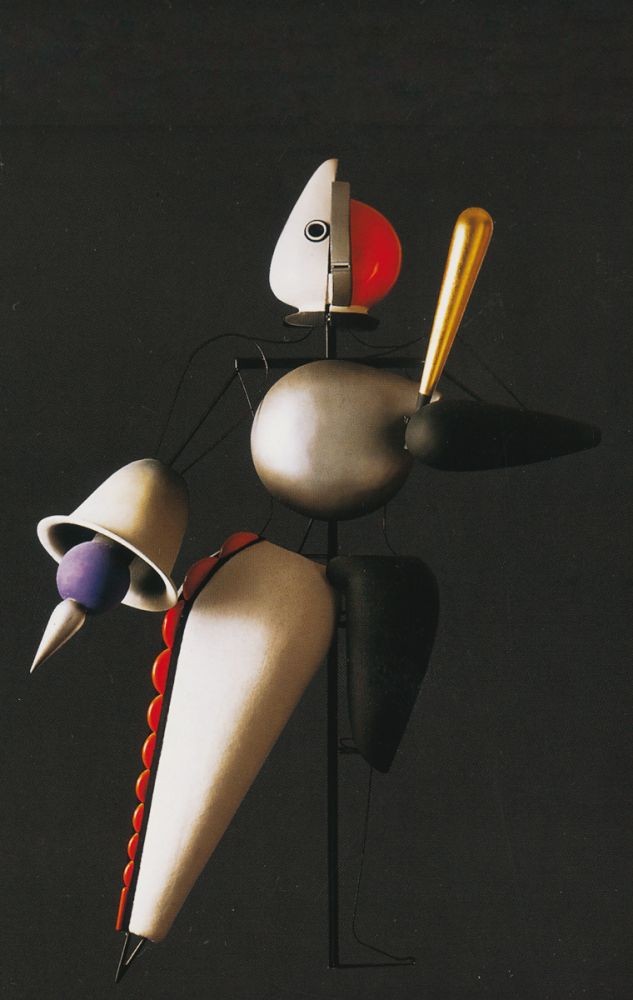Oskar Schlemmer
The Dancing Artist
13 Oct 2016 - 16 Jan 2017

Oskar Schlemmer
Ballet triadique, Séquence noire, L'Abstrait. Figure avec masque, 1920-22 (reconstruction 1967/85)
© 2016 Oskar Schlemmer, Photo Archive C. Raman Schlemmer, www.schlemmer.org
Ballet triadique, Séquence noire, L'Abstrait. Figure avec masque, 1920-22 (reconstruction 1967/85)
© 2016 Oskar Schlemmer, Photo Archive C. Raman Schlemmer, www.schlemmer.org
OSKAR SCHLEMMER
The Dancing Artist
13 October 2016 - 16 January 2017
Curator : C. Raman Schlemmer
Emma Lavigne, Director of Centre Pompidou-Metz
The Centre Pompidou-Metz is pleased to announce an exhibition dedicated to a major figure of the 20th century, the German artist and choreographer Oskar Schlemmer (1888-1943), who revolutionized dance and performance art especially within the Bauhaus.
Through his focus on bodies in motion and in relationship to space, Oskar Schlemmer laid down early and essential milestones in the history of performing arts. The present exhibition demonstrates his desire to turn performing arts into a modern art form in its own right, as embodied by his manifesto artwork, The Triadic Ballet, as well as his performances, dances and costume parties, and even his staging of works by great composers like Igor Stravinsky or Arnold Schönberg.
Schlemmer’s ambition was no less than to renew the art conceptions of his time through the combination of avantgarde thinking and humanist ideas from the Renaissance. His thoughts and theories started to give rise to entirely new art forms between 1921 and 1929, when hired as a Master of form at the Bauhaus and in charge of the seminar on “Men”.
Based on major and sensational artworks mostly coming from the Bühnen Archiv Oskar Schlemmer’s collection, the exhibition highlights Schlemmer’s artistic rigor and constant openness to novelty. Through the work of Oskar Schlemmer, we are invited to discover another side of the Bauhaus. Beyond the famous school of applied arts, the Bauhaus was also a leading place experiments in the field of performance arts and choreography in the inter-wars years, and continues to impact today’s creation.
At the center of the exhibition, the fascinating sculpture-costumes invented by Oskar Schlemmer are displayed on a large stage around which gravitates a selection of drawings. Among them are his Tanz Figurinen’s exceptional sketchbook, which captures Schlemmer’s thinking for about fifteen years, as well as photography and movie archives representative of this area. The exhibition also showcases a large selection of artworks by Giorgio de Chirico, Constantin Brancusi, Alexandra Exter and other artists met at the Bauhaus – like Vassily Kandinsky, László Mohoy- Nagy and Paul Klee- in the aim of emphasizing the reciprocal influences between Schlemmer’s work and the artists of his generation.
Along with an extensive program of events, the exhibition will be the opportunity to revive the effervescence of the Bauhaus as the ultimate place of experiments. This project makes all the more sense at the Centre Pompidou- Metz -heir of these pioneering experiments in breaking down barriers between art forms- that the Musicircus. Masterpieces from the Centre Pompidou collection exhibition exploring the relationship between music and visual arts in the 20th century, is still on in the Grande Nef.
The Dancing Artist
13 October 2016 - 16 January 2017
Curator : C. Raman Schlemmer
Emma Lavigne, Director of Centre Pompidou-Metz
The Centre Pompidou-Metz is pleased to announce an exhibition dedicated to a major figure of the 20th century, the German artist and choreographer Oskar Schlemmer (1888-1943), who revolutionized dance and performance art especially within the Bauhaus.
Through his focus on bodies in motion and in relationship to space, Oskar Schlemmer laid down early and essential milestones in the history of performing arts. The present exhibition demonstrates his desire to turn performing arts into a modern art form in its own right, as embodied by his manifesto artwork, The Triadic Ballet, as well as his performances, dances and costume parties, and even his staging of works by great composers like Igor Stravinsky or Arnold Schönberg.
Schlemmer’s ambition was no less than to renew the art conceptions of his time through the combination of avantgarde thinking and humanist ideas from the Renaissance. His thoughts and theories started to give rise to entirely new art forms between 1921 and 1929, when hired as a Master of form at the Bauhaus and in charge of the seminar on “Men”.
Based on major and sensational artworks mostly coming from the Bühnen Archiv Oskar Schlemmer’s collection, the exhibition highlights Schlemmer’s artistic rigor and constant openness to novelty. Through the work of Oskar Schlemmer, we are invited to discover another side of the Bauhaus. Beyond the famous school of applied arts, the Bauhaus was also a leading place experiments in the field of performance arts and choreography in the inter-wars years, and continues to impact today’s creation.
At the center of the exhibition, the fascinating sculpture-costumes invented by Oskar Schlemmer are displayed on a large stage around which gravitates a selection of drawings. Among them are his Tanz Figurinen’s exceptional sketchbook, which captures Schlemmer’s thinking for about fifteen years, as well as photography and movie archives representative of this area. The exhibition also showcases a large selection of artworks by Giorgio de Chirico, Constantin Brancusi, Alexandra Exter and other artists met at the Bauhaus – like Vassily Kandinsky, László Mohoy- Nagy and Paul Klee- in the aim of emphasizing the reciprocal influences between Schlemmer’s work and the artists of his generation.
Along with an extensive program of events, the exhibition will be the opportunity to revive the effervescence of the Bauhaus as the ultimate place of experiments. This project makes all the more sense at the Centre Pompidou- Metz -heir of these pioneering experiments in breaking down barriers between art forms- that the Musicircus. Masterpieces from the Centre Pompidou collection exhibition exploring the relationship between music and visual arts in the 20th century, is still on in the Grande Nef.
